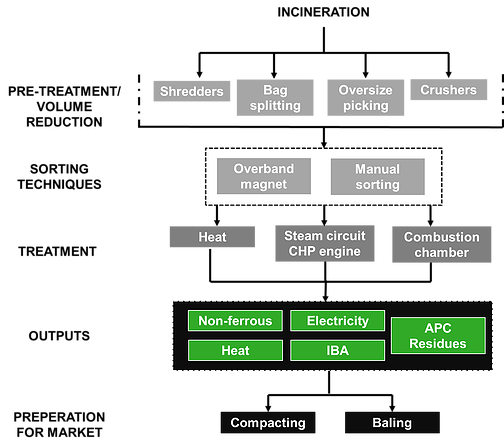Incineration is the direct combustion of material coupled with subsequent energy recovery. The heat resulting from the combustion process can be used to generate heat and electricity through a steam circuit system.

Configuration
Technology restrictions
- Not suitable for bulky or large items
- Will destroy all non-metal recyclable materials
- Requires a specialist grate to handle higher temperatures generated by refuse derived fuel (RDF)
- Energy recovery efficiencies are lower for electricity than heat
Main license requirements for inceneration
Advantages:
- Incineration is a robust technology than can be used to treat a variety of waste streams
- Revenue from both gate fees and energy generation can make the technology competitive
Disadvantages:
- Incineration is capital intensive
- Large quantities of waste to incinerate can alter plans for recycling and reuse of waste
- Flue gases can pollute the environment
- Requires feedstock to be pre-treated to a RDF, or a local producer of RDF
Waste Incinerators: A Summary of Six Case Studies
As part of the activities of the International Energy Agency (IEA) Bioenergy Agreement, members of Task 23: Energy Recovery from Thermal Conversion of Municipal Solid Waste (MSW) and Refuse Derived Fuel (RDF), visited and prepared technoeconomic case studies for several fluidized bed incinerator plants worldwide.
Among the plants evaluated were: the Robbins Resource Recovery Facility (Robbins, IL), the Toshima Incineration Plant (Tokyo, Japan), the TIRMadrid Plant (Madrid, Spain), the Valene Plant (Mantes la Jolie, France), the DERL Energy-from-Waste Facility (Dundee, Scotland), and the Lidköping Waste-to-Energy Plant (Lidköping, Sweden). The case studies, on which this summary report is based, follow this report.
Fluidized bed technologies from several vendors are employed at these plants, including Kvaerner BFBs at the DERL and Lidköping plants, Foster Wheeler CFBs at the Robbins plant, Ishikawajima-Harima (IHI) BFBs at the Toshima plant, Techniques Modernes de Chauffe (TMC) pyramidal fluidized beds (L4F) at the Valene plant, and Rowitec twin-interchanging fluidized beds (TIF) at the TIRMadrid plant. Rated electrical generation capacity from these plants ranged from 7.8 to 50 MWe, with waste feed capacities of up to 1,450 tonnes per day. Case studies prepared for the IEA Bioenergy Agreement generally examined operation of and problems with the feed preparation and combustion technology, environmental control system, and residue recovery and disposition. Additionally, fuel characteristics, mass and energy balances, and environmental performance were evaluated. Finally, capital, operating and maintenance costs, and the sociological background for each project were examined.
This summary of information from the six case studies compares and contrasts, where available, the project drivers and the effectiveness and cost of the selected incineration / environmental control technologies.
